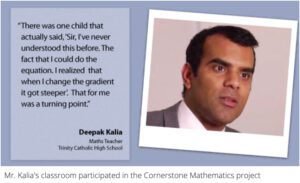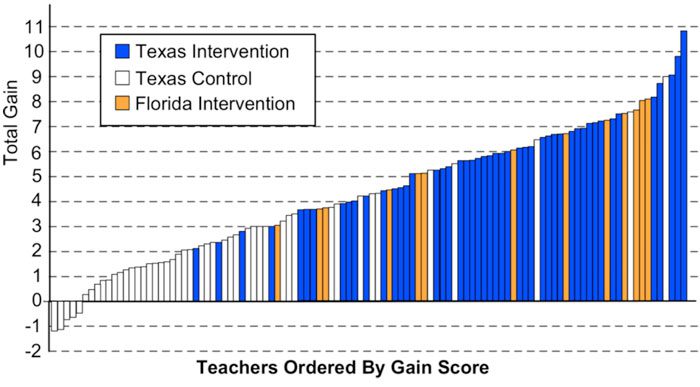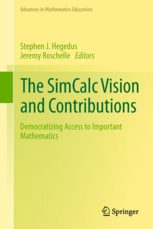Although the use of technology in math education is not new, the effectiveness of technology-enhanced teaching approaches has sometimes been controversial. Recently, SRI researchers published a series of studies that examine whether technology is effective and how it helps. Our findings show that technology can increase students’ understanding of math concepts, but only as part of a more comprehensive learning approach—one that also includes curricular content and teacher professional development.
For example, it’s widely known that the use of graphing calculators correlates with better student performance on high-profile government assessments, such as the National Assessment of Educational Progress. Yet while such correlations are reassuring, they do not constitute proof of effectiveness—and many rigorous studies have shown no effect or mixed positive and negative effects for other technology in schools. Stories of school systems that invest millions on computer hardware, only to see little change in student progress, are common.
Today, leading researchers see three clear uses for technologies in math education:
- Technology can provide multiple representations of concepts. For example, the concept of a “rate” can appear as the speed of a moving character, the slope in a graph, and a coefficient in an equation. With technology, these can be linked, so that a student who makes the slope “steeper” in a graph can see that this implies a bigger number in the equation and a faster motion an animation.
- Technology can engage students in a classroom in working on mathematics together. For example, students can collaborate to make a family of related functions to explore a pattern of variation, with technology helping to combine and integrate their unique contributions.
- Technology can provide students with more rapid feedback on the correctness of their work, enabling them to better monitor and focus their own learning.
Not by Technology Alone
SRI’s approach is to understand these capabilities of technology as one element of a complete learning activity system. This system includes the role of teachers, printed materials, curriculum, and tests. Learning scientists and educational product developers can design this system to take advantage of new high-tech capabilities based on scientific learning principles. Effectiveness, then, is not a property of the naked technology, but of the learning activity system that incorporates the technology.
In today’s leading evaluation studies, schools implement the complete package of curriculum, technology, teacher training, and tests—a more comprehensive process than just installing computers and software. Across many studies, this learning activity system perspective has yielded good results, whereas providing schools with technology alone has often failed.

SimCalc, Cornerstone Mathematics, and SunBay Mathematics are examples of the curricular activity system approach. These systems have been tested both in the U.S. and the U.K. They use technology for its ability to provide enhanced visual representations to students. For example, with a tablet device, students can change a graph on-screen and see how a resulting simulated motion also changes.
Learning scientists have established that students learn better when they have the opportunity to connect multiple representations. SRI’s mathematics modules guide teachers and students to systematically link graphs, motions, equations, tables, stories, and other key representations.
Results from a signature study appear in the chart shown below. Each vertical bar represents a classroom. The height of the bar indicates how many more test items students in that classroom got correct after two to three weeks of learning. A taller bar, therefore, represents more learning.
In a National Science Foundation-funded, gold-standard study, seventh grade classrooms in Texas were randomly assigned to one of two conditions:
- Classrooms in the treatment condition (shown in blue in the chart) used a new learning activity system featuring visual representations to learn rate and proportionality.
- Students in the control condition (shown in white) continued to use their existing textbooks for the same topic.

Which Classrooms Learned More?
Overall, the treatment classrooms (shown in blue) showed greater learning. Although there is natural variation in any educational experience—and there are always amazing teachers who can excel without specially designed materials—the vast majority of treatment classrooms learned more than the average obtained in control classrooms.
In a replication study funded by the Helios Education Foundation in Florida (shown in orange), SRI found that students in classrooms that used a slightly revised version of the materials had similar learning gains as the treatment students in Texas.

A new book, The SimCalc Vision and Contributions (Springer, January 2013), shares details of these results, along with a wealth of related research. The editors document how technology-enhanced learning activity systems can help the diversity of students found in today’s schools to learn advanced math concepts. Chapters contain insights about each factor in a complete learning activity system, including the role of curriculum, technology, teacher professional development, school leadership, and assessment. New ways to leverage classroom networks to engage students in a math community are also discussed.
SRI continues to develop Cornerstone and SunBay mathematics modules to leverage these results in U.K. and U.S. schools, and provides guidance based on its research to companies in the learning technology market.
* Chart source: Vahey, P., Roy, G. & Fueyo, V. (2013) Sustainable use of Dynamic Representational Environments: Toward a District-Wide Adoption of SimCalc-based Materials In S. Hegedus and J. Roschelle (Eds.). The SimCalc Visions and Contributions: Democratizing Access to Important Mathematics, pp. 183-202. Springer, NY


